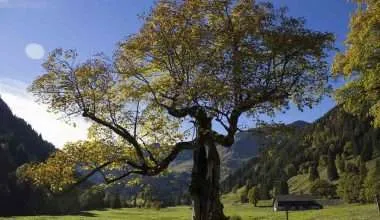Table of Contents Show
Instead of a generic tree, a palm can be classified as a woody perennial just like bamboo. There are more than 2600 species of palm trees and all of them belong to the Aceraceae family.
Palm trees belonging to different species have their respective physical characteristics. They may be in the form of shapes, size, overall appearance, etc.
In short, palm trees of different species are all visibly different from each other.
It’s better to have some basic knowledge of their common traits.
Despite their differences, they do share some common characteristics that can help in understanding the differences between the other varieties.
Common Traits/ Characteristics Of Palm Trees
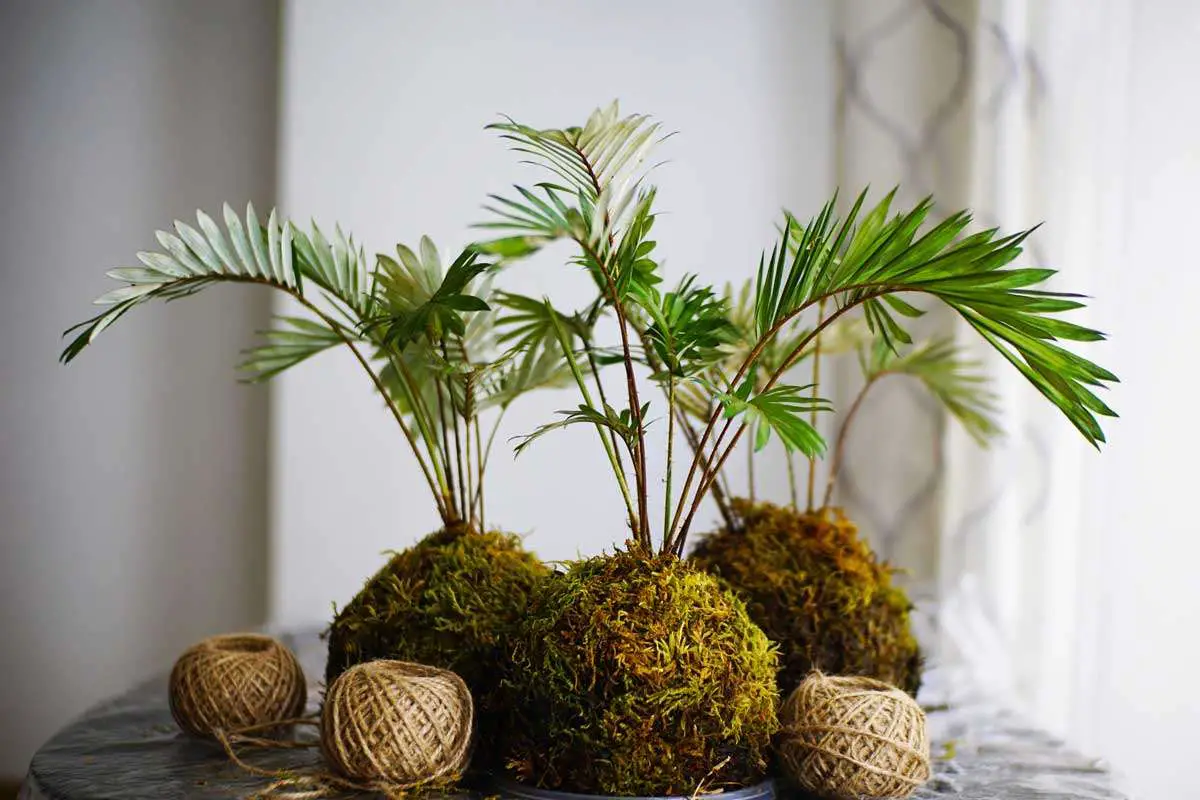
Palm trees usually have a single stalk growing directly from the ground.
Their canopy is either rounded or straight with the majority of the leaves concentrated at the top. The common leaf types are fan-shaped and feather-shaped leaves.
Usually, palm trees have their species-specific climate and settings. Some grow in deserts, some near the ocean while some grow as understory plants in rainforests.
Overall, palm trees prefer hot climate regions therefore, they are not easily available in northern regions. This is where you can have indoor palm trees.
You’ll find different varieties of palm trees outside, ranging from small and broad to tall and swaying, as long as climate and region contribute to their healthy growth.
These beautiful palm trees are very useful to us!
The following list of palm trees is divided into 3 sections, Indoor Palms, Outdoor Palms, and fruit-bearing Palm trees.
9 Types of Indoor Palm Trees
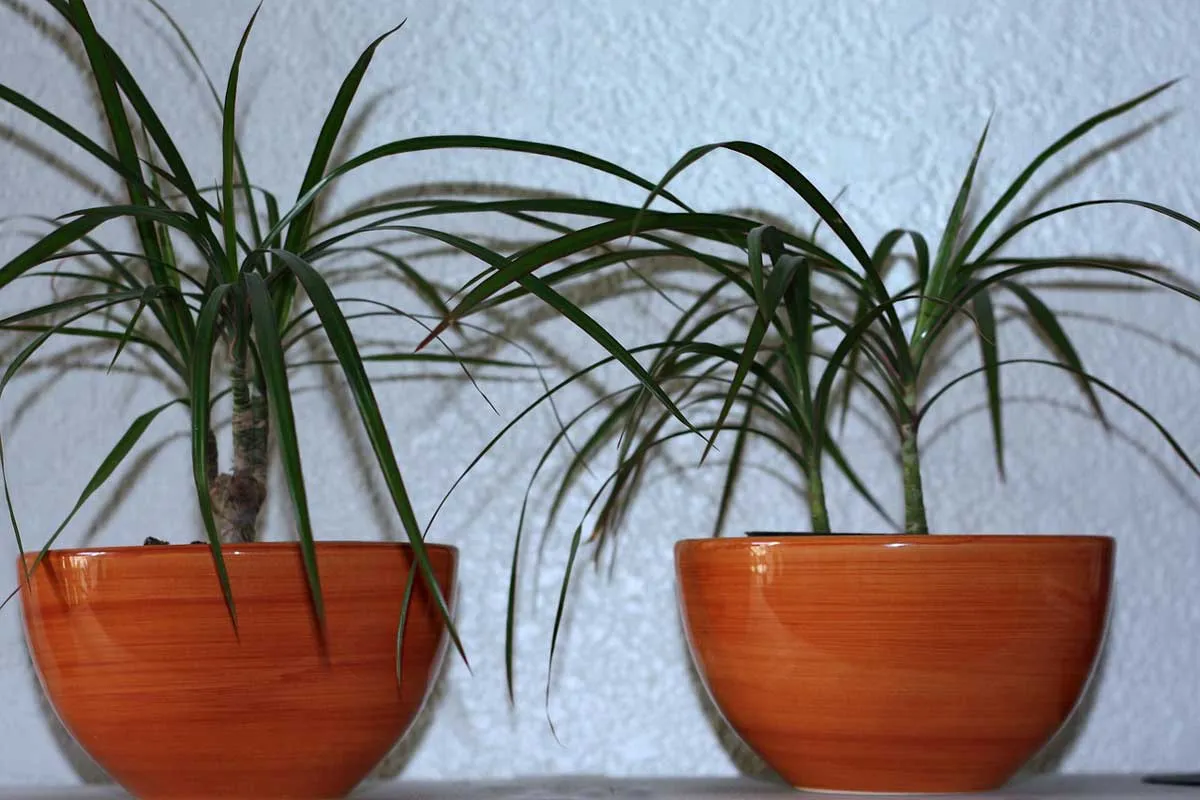
Even though palm trees prefer hotter climates, there are varieties of palm trees that can be grown indoors even in cool climates . Let’s look into some of these varieties of indoor palm trees.
1. Dwarf Date Palm (Phoenix Roebelenii)
Generally, a date palm is huge but this dwarf variety of the date palm is small enough to fit inside the house. The dwarf date palm can grow up to 5 to 6 ft. with a spread of 3 to 5 ft.
The major part of the dwarf palm is covered by its long and thin leaves which can grow up to 5ft.
It’s better to place this tree in a place where it can get ample sunlight. The dwarf palm prefers slightly acidic to neutral soil with medium moisture.

It will do well in hardiness zones 10 to 11. Dwarf date palm is a slow grower so it will take a while before it matures and reaches its full height.
2. Parlor Palm (Chamaedorea Elegans)
Parlor palm is a Mexican native tree that can grow both indoors and in the wild. It grows as an understory tree in the rainforest and reaches a height of 15 ft.
A mature indoor parlor palm only reaches less than half the height of a wild parlor palm with a spread of 5 to 10 ft.
The interesting feature of the indoor parlor palm is its attractive leaves that grow from its multiple stalks.
The multiple stalks give the parlor palm a shrub-like appearance while the leaves have ornamental value.
Ideally, parlor palm should be placed under partial to full sun but it can survive in low lights making it an excellent choice for indoors. It prefers acidic to neutral soil with medium moisture.
3. Chilean Wine Palm (Jubaea Chilensis)
Chilean wine palm can grow both indoors and outdoors with an impressive size if its requirements are met. It has a long life span but is a slow grower that can take up to 50 years to produce its first set of vibrant yellow and purple blooms.
Chilean wine palm develops a thick trunk and broad canopy full of long feathery leaves. To get the most out of it as an indoor plant, it must be placed/planted in a spot with full sun.
The maximum height it reaches is 60 to 80 ft with a spread of 20 to 25 ft when mature. It’s a drought-tolerant plant, it prefers acidic to alkaline soil and can do well in low to medium moisture. The hardiness zones are 8 to 11.
4. Dwarf Chinese Fan Palm (Livistona Chinensis)
The dwarf Chinese fan palm is an Asian native cultivar with wide prominent leaves that mimic a fan’s shape. It’s a slow grower which takes many years to mature. It can reach a height of around 5 to 7 ft with the same spread.
Dwarf Chinese fan palm prefers full sun for most of its life span except when it’s young as it requires shade during that age. It’s better as an indoor plant as it requires warmer climates and might not survive outside in colder regions.
It’s also an invasive plant so planting outside in non-native places can disrupt the plant ecosystem there.
The dwarf Chinese fan palm likes its soil to be acidic to alkaline with medium moisture. Its preferred hardiness zones are 9 to 11.
5. Cat Palm Tree (Chamaedorea Cataractarum)
Cat palm has different growing behavior than other indoor plants. Instead of having a single main stem, it grows numerous thin stems which then carry numerous elongated, deep green, and round-tipped leaves.
Cat palm prefers slightly acidic to neutral soil with medium moisture, a specific moisture level must be maintained for it to thrive. It can reach a height of 3 to 5 ft with a similar spread, the small size allows it to fit anywhere easily.
It can do well in partial to full sun in hardiness zone 11 to 12.
6. Sago Palm Tree (Cycas Revoluta)
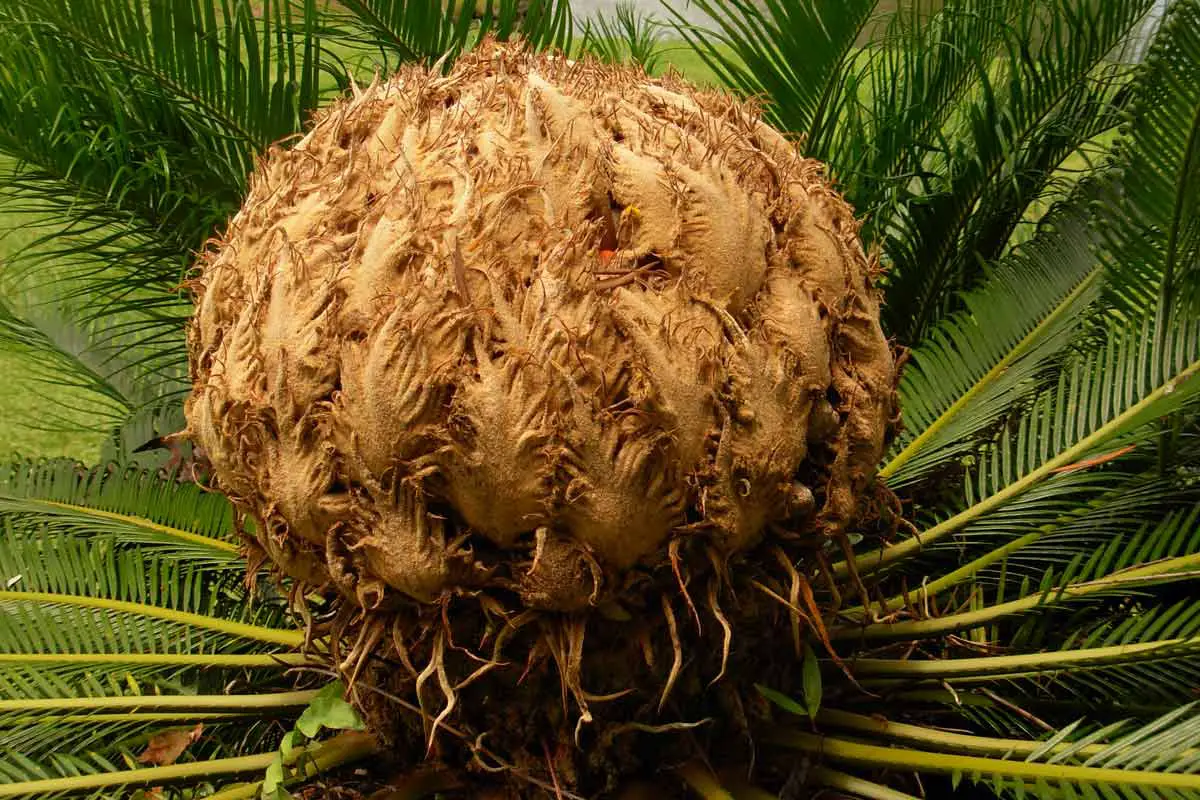
Sago palm is a tree from a cycad family and only shares the name because of its similar appearance to palm trees. It has long arching feathery textured leaves that add to its resemblance to palm trees.
It only requires 3 hours of sunlight per day and can survive in shade. The soil should be slightly acidic to neutral with low to medium moisture but must have adequate drainage.
It grows to a height of 3 to 10 ft with a similar spread and can be incorporated anywhere due to its small size. The preferred hardiness zone is 9 to 10.
7. Paradise Palm Tree (Howea Forsteriana)
Paradise palm is among the few varieties that don’t require full sun. Filtered light is its favorite although it can survive in still lower lights as well. The growth rate is slow and 6 to 8 ft. height won’t bother if it’s planted indoors.
The mature spread is 8 to 10 ft, which is more than its mature height. Paradise palm is wide overall but has a narrow trunk. the leaves are its main feature, often growing to a length of 10 ft.
In a container, it’s rare for the paradise palm to grow to its full potential which still makes it a viable option as an indoor plant. It prefers acidic soil with medium moisture and will do well in hardiness zones 9 to 11.
8. Bamboo Palm Tree (Dypsis Lutescens)
Bamboo palm is among the most commonly sold indoor palm varieties. It got its name because it grows as multiple stems come out of the ground that strongly resembles bamboo canes. It is also
Bamboo Palm is also known as Areca Palm, Golden Cane Palm, Yellow Palm and Butterfly Palm. It removes toxins such as xylene and toluene from the air while releasing oxygen. These qualities make it a popular indoor plant especially with some urban homeowners and interior designers.
Each stem carries long waving leaves at the top that often appear in sets of up to 60. The leaves can be several feet long. This indoor palm requires acidic soil with medium moisture. An ample amount of light will ensure its healthy growth.
The tree can reach a height of 12 to 30 ft with 8 to 15 ft of spread. It thrives in hardiness zones 10 to 11.
9. Ponytail Palm Tree (Beaucarnea Recurvata)
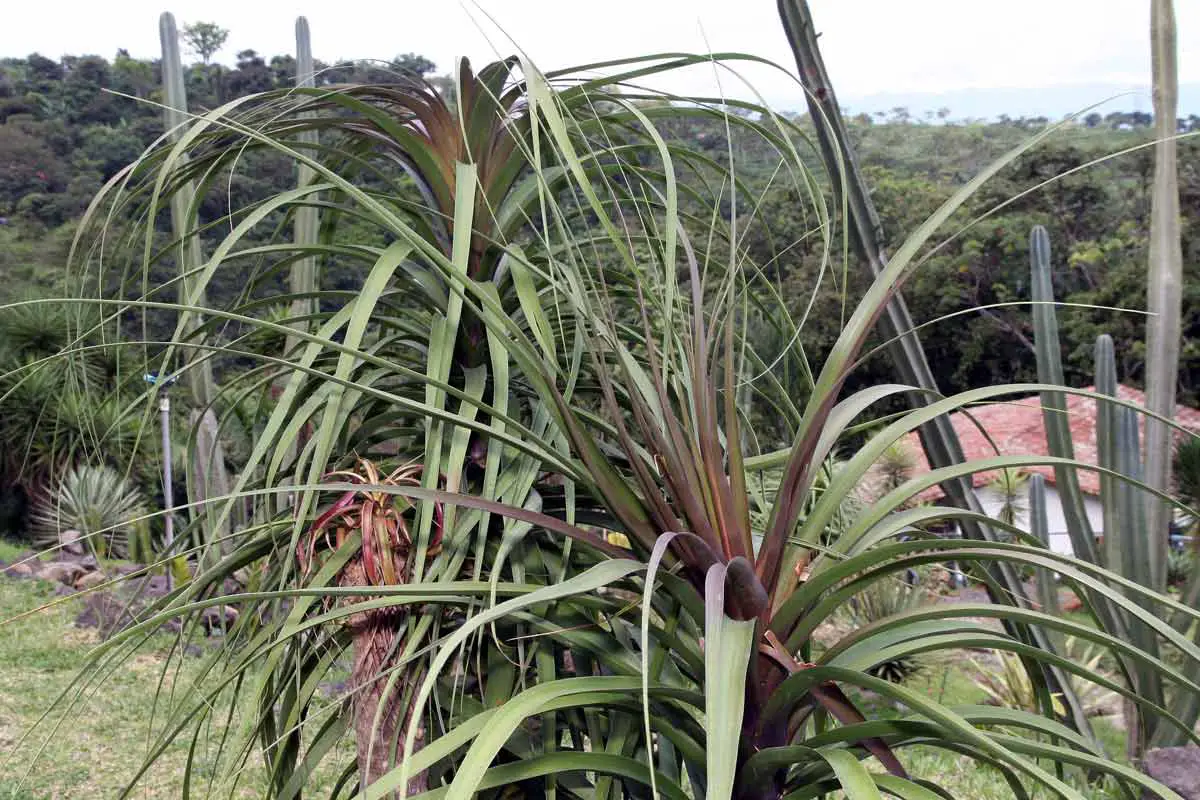
The ponytail palm is an attention grabber due to its growth habit. Its trunk bulges to retain water and has a broad appearance. The leaves are long, thin, and flowing which resembles a ponytail on the head with flowing hair.
In the wild, it can grow much larger but as an indoor plant, it grows to 6 to 8 ft tall with a 3 to 5 ft spread. It grows in hardiness zones 10 to 11 under full sun in slightly acidic to slightly alkaline soil. The soil should have medium moisture.
8 Types of Outdoor Palm Trees

The magnificence of outdoor/wild palm trees lies in their massive height and appearance.
Being in their native environment in the wild gives them the edge to grow to the fullest of their abilities. We will walk through some of these impressive varieties of wild palm trees.
1. Royal Palm Tree (Roystonea Regia)
This variety originates from Mexico despite having alternate names such as Floria or Cuban royal palm tree. It’s a common wild tree growing in hardiness zones 10 -11.
The royal palm can reach an impressive size of 80 to 100 ft but has a far smaller spread of 15 to 20 ft. Its trunk has a minimal gray texture with around 10 leaves on it, each containing many leaflets.
Royal palm can survive in the shade when young, but the full sun becomes a necessity as it ages. The soil should be neutral to slightly alkaline with high moisture.
2. Foxtail Palm (Wodyetia Bifurcata)
The Foxtail palm is native to the Australian outback and resembles the royal palm in many ways.
The distinguishable feature is its size, it can only reach around half the size of the royal palm which is 40 to 50 ft with a spread of 10 to 15 ft.
The foxtail palm consists of large sets of feathery leaves resembling a huge foxtail. It grows under partial to full sun in hardiness zone 9 to 12. This variety of the palm prefers slightly acidic to neutral soil with medium moisture.
3. European Fan Palm (Chamaerops Humilis)
This is the only palm variety native to Europe. European fan palm can grow as a shrub and a small tree that has a height of 6 to 15 ft with 6 to 20 ft of spread.
European fan palm grows with multiple trunks of the same size. This habit can be prevented to promote single stem growth if it suits your needs.
The leaves of this variety are both thin and wide. You will find many sharp points in the foliage due to the divisions of these thin leaves.
European fan palm grows in hardiness zones 9 to 11. It grows under partial to full sun in an acidic to neutral soil. Medium moisture must be maintained in the soil.
4. Mexican Fan Palm (Washingtonia Robusta)
Mexican fan palm is native to Mexico and parts of the American southwest. It’s a fast-growing tree that has a long life span. An impressive trait of this palm tree is its adaptability to the soil of any pH and any level of moisture.
Mexican fan palm is very tall but has a small spread in comparison. It reaches a height of 80 to 100 ft with a spread of only 5 to 10 ft. Mexican fan palm has tiny black edible fruits and its leaves are also used in several handmade items.
This variety of palm trees grows under partial to full sun in hardiness zones 9 to 11.
5. Chinese Fan Palm (Livistona Chinensis)
The Floridian landscape is filled with Chinese fan palms even though it’s a species native to China. Despite it being an invasive plant, its popularity as an ornamental tree hasn’t faded. Another reason for its popularity would be its preference for dry soils.
The textured leaves of the Chinese fan palm can acquire a drooping appearance sometimes, it can reach a massive length of 6 ft. The overall size of the tree is 40 to 50 ft with a mature spread of 15 to 20 ft.
This variety of fan palm trees prefers acidic to alkaline soil with dry to high moisture.
6. Triangle Palm (Dypsis Decaryi)
Triangle palm is native to Madagascar. It’s a small to medium-sized tree with excellent drought tolerance and requires very little water to survive. It also requires little pruning making it a very low-maintenance tree.
The Triangle palm is loved for its unique aesthetically pleasing appearance. It has a flat canopy resembling a two-dimensional triangle shape. It grows in a wide range of soils and is pest resilient as well.
The triangle palm grows 10 to 15 ft tall with a 25 to 30 ft spread. It thrives in hardiness zones 10 to 13 under full sun. The soil can be acidic or alkaline and only require low to medium moisture.
7. Guadalupe Palm (Brahea Edulis)
Guadalupe palm is an extremely low-maintenance palm variety. It requires little to no pruning and or any care related to diseases. Once it’s established, it only requires occasional watering on really hot days.
It’s a single stem tree of medium size that rarely exceeds 30 ft. Overall height of this tree would be 30 to 40 ft with 10 to 15 ft of spread. The leaves are broad and fan-shaped. Guadalupe palm also offers edible fruits with sweet and soft flesh.
The hardiness zones for Guadalupe palm are 9 to 10. It requires full sun with acidic to alkaline soil having low to medium moisture.
8. Jelly Palm (Butia Capitata)
Jelly palm is native to warm regions of South America. Despite that, it is cold resistant and can survive temperatures as low as 20 degrees Fahrenheit.
Jelly palm is among the most attractive varieties of palm trees. The leaves of the jelly palm arch from the stem and you can see on its textured trunk where the old leaves once grew.
You can also find fragrant yellow flowers (nearly 3 ft long) on the jelly palm that leads to a cluster of fruits that you can eat.
Jelly palm isn’t picky when it comes to soil, it can survive in a wide range of soils from acidic to alkaline. It’s also a low-maintenance tree that doesn’t require help with any disease.
The maximum height of the jelly palm is 15 to 20 ft with a 10 to 15 ft spread. It grows under partial to full sun in the soil of medium moisture.
5 Types of Fruit-Bearing Palm Trees
There are varieties of palm trees that bear edible fruits. Many items featured in general stores come from palm trees. Some lesser-known fruits from palm trees are used in medicines and as a key ingredient in regional dishes of their native places.
1. Coconut Palm (Cocos Nucifera)
Coconuts come from palm trees. It is 12 to 18 inches long fruit containing only a single edible seed. The fruit is covered in a hard fibrous exterior that protects the seed and fruit inside.
Coconut palms require hot weather to grow, if it doesn’t receive enough heat then there won’t be any fruits either. You’ll also find large aromatic flowers on palm trees.
In some regions, the coconut palm is listed as an invasive species. It grows to 50 to 100 ft tall with a 20 to 40 ft spread. Hardiness zones 10 to 12 are preferred with full sun. The soil should be acidic to neutral with medium moisture.
2. Date Palm (Phoenix Dactylifera)
The delicious and nutritious dates come from the date palm tree, which is native to the Middle East. When the right conditions are met, these trees will produce a huge amount of date fruits.
The dates are green when young and change to reddish brown when they ripen. Once established, the tree requires no care or pruning to grow and produce fruits.
It grows to 80 ft tall with a spread of around 40 ft. It has large feathery leaves that cover most of the canopy. The date palm requires full sun with soil that doesn’t have much moisture.
3. Acai Palm (Euterpe Oleracea)
Acai palm grows as an understory plant in partial to full shade. The tree is narrow with long upright leaves. The tree grows 50 to 100 ft tall with a spread of only 10 to 20 ft.
It produces edible berries, which according to some, have medicinal qualities. Moreover, berries are delicious and flavorful in taste.
Acai palm grows in acidic to neutral soil with high moisture, although it prefers acidic more. It will take several years to produce berries after it is established in the soil. The hardness zones are 10 to 12 for acai palm.
4. Peach Palm (Bactris Gasipaes)
Peach palm is from the rainy areas of central America where it grows in wet soils under full sun. The palm produces fruits for most of its life and it is used as food by locals in its native region for both themselves and their cattle.
The large fruit produced by peach palm isn’t a peach but is something that resembles a peach. This fruit isn’t the most commonly eaten part of the peach palm but the heart of the peach palm tree is. This is made of tender unopened leaves and is creamy white with tinges of yellow and pink. The fruit has to go through a long process so it is safe for others to consume.
The peach palm grows in hardiness zones 10 to 11 in acidic to neutral soil with medium to high moisture. It grows to be 65 to 100 ft tall with 20 to 30 ft of spread.
5. Elaeis Guineensis (Oil Palm)
In Africa as well as in Malaysia and Indonesia, oil palm is cultivated in prodigious quantities. Oil palm’s value throughout the world is due to the oil-based products that are produced by it.
Some common products that are acquired through oil palm are cooking oil, cosmetics, soaps, etc. The seeds of the fruit are the main ingredients, overall the fruit is large and red to orange in color.
Oil palm has a mature height of around 40 to 50 ft with 15 to 20 ft of spread. It requires acidic to alkaline soil with high moisture and full sun which you can find in sub-tropical regions. The hardiness zones are 10 to 12.



